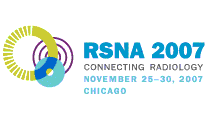
Abstract Archives of the RSNA, 2007
LL-NR4066-L10
Accurate Quantitative CTP Map Construction in Acute Stroke Patients with Unilateral MCA Thrombus: Use the Left or Use the Right, But Donít Place the Arterial Input Function ROI Distal to the Occlusion
Scientific Posters
Presented on November 28, 2007
Presented as part of LL-NR-L: Neuroradiology/Head and Neck
Rafael Ferreira MD, Presenter: Nothing to Disclose
Shahmir Kamalian MD, Abstract Co-Author: Nothing to Disclose
Gregory V. Goldmakher MD, PhD, Abstract Co-Author: Nothing to Disclose
Ramon Gilberto Gonzalez MD, PhD, Abstract Co-Author: Grant, Bayer AG (Berlex Inc)
Pamela Whitney Schaefer MD, Abstract Co-Author: Nothing to Disclose
Michael H. Lev MD, Abstract Co-Author: Speaker, General Electric Company
Advisory Board, General Electric Company
Research support, General Electric Company
Speaker, Bracco Group
Advisory Board, Bracco Group
Advisory Board, CoAxia, Inc
Using post-processing software from two different commercial vendors for CT perfusion (CTP) map construction in acute stroke patients, we sought to determine the degree to which the quantitative CBV, CBF, and MTT values vary with the placement of the arterial input function (AIF) region-of-interest (ROI): (1) ipsilateral proximal versus contralateral proximal, and (2) ipsilateral proximal versus ipsilateral distal, to the site of arterial thrombus.
A neuroradiologist constructed CTP maps using deconvolution-based software from two commercial vendors for 14 acute stroke patients. All cases had unilateral proximal middle cerebral artery (MCA) clot confirmed by CTA, as well as infarct core confirmed by DWI. CTP maps were generated by varying the AIF ROI placement in 4 positions relative to the MCA thrombus, as noted above. The remaining technical parameters were held constant. For each map, the CBV, CBF and MTT values were sampled in the following locations: core, healthy gray matter and healthy white matter.
Using the software from both vendors, there was no significant difference between perfusion values so long as the AIF ROI’s were placed proximal to the site of MCA thrombus. With the standard deconvolution software, there were moderate increases in the CBV and CBF values and decrease in the MTT values, when the AIF ROI’s were positioned distal to the MCA thrombus (18%, 28%, and –20%, respectively).With the delay corrected software, these changes were less marked (14%,20%, and –13%, respectively).
For accurate CTP map construction, laterality of AIF ROI placement is less important than avoiding placement distal to an MCA occlusion. This pitfall is less severe with delay-corrected deconvolution software.
Available software packages can be used to automatically segment ischemic regions on CTP maps based on quantitative thresholds, aiding triage. Their accuracy depends on using an appropriate AIF ROI.
Ferreira, R,
Kamalian, S,
Goldmakher, G,
Gonzalez, R,
Schaefer, P,
Lev, M,
Accurate Quantitative CTP Map Construction in Acute Stroke Patients with Unilateral MCA Thrombus: Use the Left or Use the Right, But Donít Place the Arterial Input Function ROI Distal to the Occlusion. Radiological Society of North America 2007 Scientific Assembly and Annual Meeting, November 25 - November 30, 2007 ,Chicago IL.
http://archive.rsna.org/2007/5015931.html

